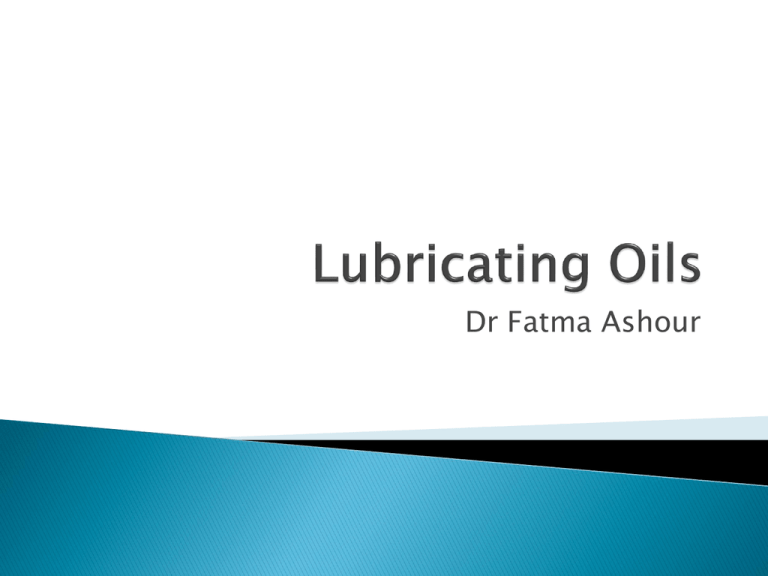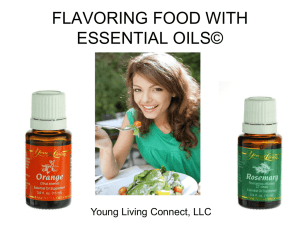Lubricating Oils
advertisement

Dr Fatma Ashour Lubricating oils (or “Lube Oils are heavy petroleum fractions used to lubricate metallic surfaces which are in relative motion with respect to one another. The essential aim of these oils is to minimize the friction between the moving surfaces and hence, prevent mechanical wear in the metals, and to absorb the heat of friction. General steps followed in producing finished lubricating oils are: A-The crude oil is initially fractionated under atmospheric pressure to produce the conventional top products (gases and gasoline) side products (kerosene, gas oil, and perhaps diesel oil) and a bottom product, usually known as the “Long Residue” (known as Mazot). B-The long residue is then fractionated under vacuum to produce a top product used for diesel oil, and side products which could be used for producing finished lube oils. These side products of the vacuum tower are known as “Wax Distillates” The bottom product of the vacuum tower, known as the “short Residue”, may be asphalt on heavy oil. In either case, this bottom product could be used for producing heavy lubricating oils, which are then called “Residual Oils”. The products obtained from the vacuum distillation tower (cannot be marketed as such. They should be refined to produce the required grade of finished lube oils. Deasphalted to remove any asphalt they may contain Solvent refined to decrease the effect of temperature on its viscosity (i.e. improve its Kinematic Viscosity Index-KVI) Dewaxed” and possibly “percolated through clay” to remove any solid particles or coloring material Neutralized”, especially if they have been previously subjected to acid treatment. In general, there are FOUR basic “Lube Oil Stocks” - three of which are distillate oils and one is a residual oil. As a matter of fact, more “basic stocks” could be produced by the vacuum distillation of one or more of the previously obtained oils. Basic stocks are then “blended” with one another, in various proportions, to produce the optimum viscosity range necessary for the market. The lube oil is finally “compounded” by the addition of various additives to improve the quality of the oil. After compounding, the finished lube oil is ready for selling on the market. Viscosity: Lube oils should have a “suitable viscosity”. As a matter of fact, for a certain lubricating job, the lube oil must have a definite optimum viscosity. Below this optimum viscosity, the lube oil cannot properly prevent the friction between the moving metallic parts; while above this optimum viscosity, the lube oil itself requires a greater power to overcome its high resistance to motion, and consequently this is a waste of power. To determine the optimum viscosity required of a certain lubrication job, use is made of the fact that the “Coefficient of Friction” between any moving surfaces depends upon the following “dimensionless group”[ N/P] Where, = viscosity of the lube oil. N = relative speed of the moving surfaces. P = stress between the moving surfaces. Since the values of N and P are fixed by the operating conditions, then for minimum friction, the value of is also fixed. For minimum friction, higher viscosity oils are required for low speeds of rotation and for high stresses between the moving surfaces. Conversely, lower viscosity oils are required for high speeds of rotation and low stresses between the moving surfaces. Examples of the choice of the optimum viscosity of lube oils are given below: In the case of lubricating, textile spindles, the pressure load is very low and the speed of rotation is very high consequently, the proper lube oil to be used should have a very low viscosity. For this reason, lube oils with the lowest viscosity are known as “spindle oils”. In the case of lubricating cylinders of big engines, the speed is relatively low and the pressure is high, thus the proper lube oil to be used should have a relatively high viscosity. Such lube oils are known as “Cylinder oils”. In case of lubricating gears, the stresses on the gears are very high, while the relative motion is significantly low; accordingly, lube oils of very high viscosities are therefore needed, and these are called “Gear Oils”. N.B: Gear oils and cylinder stocks are usually manufactured from residual oils. The K.V.I is a measure of the variation of viscosity with temperature. As a rule, the viscosity of a lube oil decreases with increase in temperature. The variation of viscosity with temperature depends upon: - The type of crude - The extent of refining As a matter of fact, paraffinic hydrocarbons change their viscosities to a smaller extent than naphthenic ones. This scale has been developed on the basis of Two “Reference Crudes” namely: i. Pennsylvanian Crude (PC) - highly paraffinic crude. ii. Gulf Coast Crude (GCC) - highly Naphthenic crude. Any lube oil derived from the first reference crude would have a relatively small variation of viscosity with temperature, and is arbitrarily given a K.V.I value of 100. On the other hand, any lube oil derived from the second reference crude would show large variations of viscosity with temperatures, and is therefore given a K.V.I value of zero. To find the K.V.I of any lube oil, its kinematic viscosity at two standard temperature levels of 210˚and 100˚F is measured. Generally lube oils are broadly classified into the following TWO grades according to their K.V.I values: Premium grade oil having a K.V.I of 85 or higher. Regular grade oils having a K.V.I of 80 or less. N.B. Lube oils having K.V.I values between those 2 grades are sometimes called “Intermediate grade oils”. Furthermore, lube oils are not marketed unless their K.V.I. value is at least 70 (not less). Some lubes have a K.V.I value higher than 100; this means that the change of their viscosities with temperature is less than the change in viscosity of the corresponding lube oil from the first reference crude. Such a lube could only be obtained by: Starting from crude which is more paraffinic than the Pennsylvanian crude (PC) Subjecting the lube to intensive solvent refining Adding, certain additives known to increase the K.V.I such additives are known as “VI-improvers”. N.B. Similarly oil with a (-ve ) K.V.I indicates that the variation in viscosity (kinematic viscosity) with temperature is greater than the variation of the kinematic viscosity of the Gulf Coast reference crude (GCC). Stricter environmental requirements and mileage standards for new cars have created a growing demand for high-quality multigrade motor oils which have lower volatility and oil consumption characteristics and reduced thickening of the oil by oxidation during service which increases fuel consumption. Solvent refined oils have difficulty in meeting the new standards and are increasingly being replaced with hydrocracked and poly-alpha-olefin based oils, especially in the lower viscosity grades such as 5W-30 and 10W-30 multigrades. The low-viscosity multigrade oils are typically blended from low-viscosity mineral-based oils which have volatilities and tendency to high oil-consumption and rapid thickening by oxidation during service. Hydrocracking of base stocks, followed by solvent extraction to remove partially hydrocracked aromatic compounds, offers a more cost-effective route than production of poly-alphaolefins Wax particles in lube oils are undesirable for the following reasons: A high wax content results in a high pour point, hence the lube will tend to solidify in cold weather conditions (causing friction). Wax is susceptible to cracking at high T & P. Hard solid particles deposited on the lubricated surfaces will increase the friction. Wax is easily oxidized and will result in the breaking of the chain into shorter molecules, and hence the viscosity is lowered. N.B. Wax was formerly removed from lube oils by “Chilling” operations, wherein the wax solidifies and could then be filtered off, or left to SWEAT. More modern dewaxing methods are now adopted using “Solvent Refining” methods, (e.g. using propane or ketones especially methyl ethyl ketone – MEK). As a matter of fact, the oil is soluble in these liquid solvents, and thus the wax could be filtered off. Asphaltic particles are undesirable because they would tend to stick to the lubricated surface and increase the friction between them. Deasphalting is therefore one of the main processes adopted in lube oil refining. Sulphuric acid treatment or “percolation through active clay” to adsorb the asphaltic particles. Solvent extraction processes. Typical solvent used is propane- ie the “propane deasphalting” methods. In this process, the propane dissolves the oil and leaves the asphaltenes (hard asphaltic particles) to deposit and could be separated by filtration. The most important refining operations to which these raw fractions are subjected to are outlined in the following steps: 1- Deasphalting: to remove any solid or asphaltic particles which deposit on the lubricating surfaces causing friction. Deasphalting is accomplished by the following methods: A- H2SO4 treatment (98%): carried out in a series of agitation and settling tanks at temperatures ranging from 35-65 C and not higher because of possible cracking. B- Clay treatment: the raw fractions are basically percolated through active clay. C- Solvent extraction: the raw fractions are essentially dissolved in a suitable solvent (e.g. propane) whereby asphaltic particles are deposited and can thus be removed. 2- Solvent Extraction: to improve the KVI of the lube oil through the removal of ring compounds, namely naphthenes and aromatics whose viscosities change substantially with tempt. This is achieved by a solvent extraction process using special “selective solvents” such as phenol, chlorex, and above all furfural which is presently the most widely used solvent. Solvent refining process is carried out to remove naphthenes & aromatics (in addition to acids) thus resulting in the improvement of the KVI of the finished lube oil. The most widely used solvent is Furfural (a liquid aldehyde of B.P = 180C, heavier than water but miscible with it, obtained as a byproduct in the starch industry-especially when starch is produced from maize). N.B. Such a solvent, called a “Selective solvent”, only dissolve the ring structures which DO NOT have a LONG side chain (i.e. : those which lower the KVI), this is because such ring structures with a long side chain could break to n-paraffins that have a high KVI. Flash Point: Normally, the flash point of lube oil is not of particular importance. It is sometimes essential however, to have lube oils with high flash points. Such oils could be obtained by “steam refining” (ie. by flashing the lighter constituents in the oil using superheated steam). These oils having high flash points are referred to as “steam refined oils”. For example, lubricating oil given the grade (600 SR) indicates oil which has been steam refined and whose flash point is 600˚F. N.B. The flash point of lube oil is used to detect contamination with lighter volatile hydrocarbons. Ex: Crank-case oil when it is contaminated with gasoline. Flash point determination is the easiest method to detect such a contamination (or cheating). Acidity: Acidity in the lube oil resulting from mineral or organic acids, leads to corrosion of the lubricated surfaces. Hence, any acidity in the lube oil must be neutralized before marketing. Solid lime is usually used for that purpose. Emulsification: When the lube oil is to be used in high speed steam turbines, it usually has the tendency to form emulsions with the water. Such emulsions destroy the lubricating properties of the oil. For this reason, certain additives are used to reduce such a tendency. Furfural is a liquid aldehyde, which is susceptible to oxidation, hence the lube oil charge (feed) must be deaerated before mixing it with the solvent, by passing it through a “Deaerator” which is subjected to a vacuum system. The deaerated lube is then introduced into an Extraction tower where it meats a counter current flow of the furfural solvent. The raffinate will be obtained through the top of the extractor while the extract will be obtained through the bottom. N.B. Both the raffinate and the extract contain some solvent which must be recovered. Accordingly, both streams are subjected to a series of fractionation Process followed by steam stripping to recover the furfural solvent. The solvent furfural, recovered from the various parts of the plant, is collected then mixed with the make-up solvent and finally recycled to the extractor tower Dewaxing process is carried out by: Clay treatment Chilling operation and most widely by solvent extraction. In the latter method, the solvents generally used are ketones of different types (e.g.: acetone, methyl – ethyl ketone MEK, propyl – ethyl ketone or diethyl ketone) N.B. It has been found that “Ketones” are excellent dewaxing agents whereby they dissolve the oil and precipitate the wax. Furthermore, it has also been found that when aromatics are mixed with ketones (i.e.: in the form of a “Solvent Mixture”) then, the aromatics reduce the solubility of the wax in oil resulting in a higher efficiency of dewaxing (greater than the propane dewaxing process). The most widely used dewaxing process is the “MEK Dewaxing Process” where the solvent ketone is methyl ethyl ketone (MEK) and the mixed aromatics are essentially benzene and toluene in approximately the following proportions: MEK = 65% Solvent Mixture : Benzene = 25% Toluene = 10% Propane deasphalting is based on the fact that liquid propane is capable of dissolving the lube oil & precipitating the asphaltic particles. N.B. The rate of precipitation (i.e. the extractive power) of asphaltic particle is increased by increasing the temperature. It has been found the optimum operating temp is about 70C (not higher otherwise the paraffin would crack) using a high press of 450 psi (to maintain the propane in the liquid phase). The lube oil and liquid propane are contacted in vertical drums which are heated by internal steam coils. These drums are maintained at the required operating conditions (70C & 450 psi). The asphalt is obtained from the bottom while the lube oil, containing the main bulk of the propane solvent, is withdrawn from the top. N.B. Both the “raffinate” (lube oil) and the “extract” (asphalt) contain propane. This propane is recovered by heating and evaporation using a TSH for asphalt and a reboiler for the lube oil. The reboiler still contains some propane which is removed by a stripper (i.e: using S.H.S). Asphaltic particles are obtained as a bottom product from a stripper. N.B. The propane obtained from the various parts of the process units, is collected, compressed and mixed with make-up propane then finally recycled with the feed. Advantages of this Process: a) Propane could be obtained from the refinery at a cheap price. b) Efficiency of separation is very high. c) Only asphaltenes are removed hence the oil, originally present with the asphalt, is recovered with the lube oil. d) This method could be applied to any lube oil. Disadvantages of this Process: The only disadvantage is that hard asphaltenes have No use. This was overcome by any of the following procedures: i) Adding them to soft asphalt to increase its hardness. ii) Adding them to viscous Fuel Oil to convert it to ordinary F.O. iii) Adding them to soft asphalt then blowing with hot air to produce much harder grade of asphalt, known as “Air blown asphalt”.








